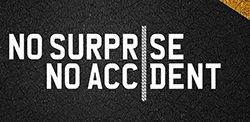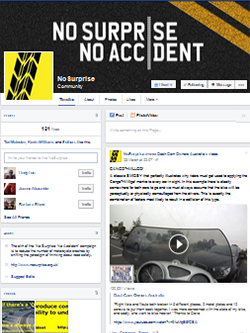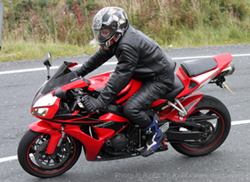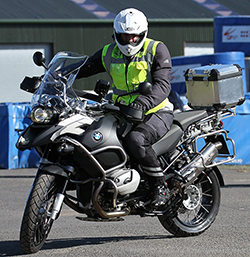
“All accidents are the result of prediction failure. Surprise is Nature’s way of telling us we have experienced such a failure. If there is no surprise, there can be no accident”
The aim of the ‘No Surprise: No Accident’ campaign is to reduce the number of motorcycle crashes by shifting the way we think about road safety.
No Surprise – No Accident argues that we need new and original thinking to tackle old problems, a new paradigm for motorcycle safety.
Take the time to read through the article below at times it will seem a bit heavy going but to understand a “new” way of thinking then some thought needs to given to understand it!
Perfectly Normal And Controlled Ride
For a long time, it’s been assumed that if you teach people to a suitable level of skill and then ensure they conform to a set of rules, they won’t crash.
From that perspective, it’s easy to assume that those people who do crash therefore either have inadequate skills or broke the rules.
Typical descriptions of crashes use phrases like “lost control” or “too fast for the conditions”.
But a moment’s logical thinking shows there’s a problem with this description of the event. The rider clearly was “in control” and “wasn’t too fast for the conditions” a mile back up the road or they would have crashed there instead. Throughout their journey they were only considered to be ‘out of control’ or ‘too fast for the conditions’ at the precise point they crashed.
So what changed at that exact point? What turned a perfectly normal and controlled ride at a pace that was entirely suitable for the conditions into a nightmare of twisted metal and pain?
To answer this question, let’s look at what we do know already.
What Do We Know Already
 We know where motorcyclists crash because the majority of crashes involving motorcycles happen in the same places over and over. Just think about the two most common crashes; the collision with a turning car and the rider who crashes on a bend.
We know where motorcyclists crash because the majority of crashes involving motorcycles happen in the same places over and over. Just think about the two most common crashes; the collision with a turning car and the rider who crashes on a bend.
We know why people crash – an inappropriate response at the important moment, whether that’s changing speed or changing direction in the wrong way, or failing to make an input when one was needed.
We also know what those inappropriate responses are. Keith Code got a big chunk of the answer with his ‘Survival Reactions’ that he wrote about in ‘Twist of the Wrist 2’, where he talked about inappropriate reactions like target fixation, freezing on the steering, grabbing a big handful of brake.
The next point is that we also know that many people who crash as a result of making those inappropriate responses were actually trained to make the right inputs. Emergency stops have been part of rider training for decades and for the last couple of years riders have been trained to swerve too.
So why don’t riders deploy their crash avoidance skills when they need them?
Surprise Derails Our Brains
For years, that’s been the question that’s not been addressed. The logical step forward that ‘No Surprise’ has made is to identify that the trigger for these inappropriate reactions all revolves around just how the rider perceives the developing situation in the last few and crucial seconds; in fact, right where the right input would prevent a crash.
The key factor preventing the correct response turns out to be that our expectation of how the situation develops turns out to be at odds with how it actually develops. What happens isn’t what we were expecting. And the result is surprise.
Surprise derails our brain’s learned responses to situations it’s dealt with in the past.
An important point here is to understand how we process the information that comes in to our brain in real-time. The neo-cortex, the bit of the brain that makes us human, filters incoming data from our various senses. It compares that incoming data stream with data streams that we have experienced before and stored in memory. Should the neo-cortex detect anything novel in the incoming data we will we will start thinking about the novelty, deciding whether or not that novelty represents a threat and deciding how we’re going to deal with it if it does.
But should the incoming data appear to match scenarios that have already been successfully negotiated, then the neo-cortex automates the task by running the program that is the best fit for what it sees, a program that it’s learned by experience has worked in similar situations in the past.
Remember learning to catch? In the very earliest stages of learning this very complex perceptual/motor task we had to work out just how to judge the flight of the ball and time our own movement to intercept it. Initially we weren’t very good at it at all, but as we gained more experience of how the ball travels through time and space we were able to catch the ball much more easily as the neo-cortex controlled our muscles without conscious input.
If someone shouts “catch”, we look round to see who called to us and prepare to track the ball in the air, and move in a way to make a controlled catch. That’s a learned response, and it’s thanks to these learnt responses we can perform these tasks without conscious thinking. Catching practice allows us to experience many different ball trajectories’ which in turn reduces the level of novelty in each ball’s flight. The process we use to learn to catch a ball is exactly the same as we learn to process tasks as we ride the bike. The process of learning through repetition and practice reduces the potential novelty in a situation and as a result reduces the potential for something surprising to happen.
And then something happens that doesn’t fit the program.
The Reptilian Brain
 Think what we do if someone unexpectedly throws a ball at our head – we duck or put a hand up to deflect it and protect our face without any conscious thought. If there’s an immediate threat of personal harm, then a much older bit of the brain automatically kicks in to defend us from the threat. This primitive ‘reptilian brain’ is entirely beyond our conscious control, but we rely on it to control our ‘fight or flight’ reactions to sudden or threatening events.
Think what we do if someone unexpectedly throws a ball at our head – we duck or put a hand up to deflect it and protect our face without any conscious thought. If there’s an immediate threat of personal harm, then a much older bit of the brain automatically kicks in to defend us from the threat. This primitive ‘reptilian brain’ is entirely beyond our conscious control, but we rely on it to control our ‘fight or flight’ reactions to sudden or threatening events.
The reptilian brain is always alert to deal with threats that are beyond the capability of our neo-cortex to manage and this is a significant key fact in ‘No Surprise – No accident’. Because it is understanding that it’s the event that we
DIDN’T predict that is the issue, if we become surprised by a novel and unpredicted event we’re at risk of having our reptilian brain take over and trigger those inappropriate ‘survival reactions’ and that is NOT good for our bike control.
What we are calling ‘Prediction failures’ are a discrepancy between what we predicted was going to happen and were prepared for, and how the last few seconds actually developed. The bigger the gulf between the scenarios we were mentally prepared for and the scenario actually experienced, the less chance we have of preventing our reptilian brain taking over with some inappropriate action.
Reptiles can’t ride motorbikes so we have to take all possible steps to ensure that the reptile sitting waiting in our brain never gets the opportunity to try.
But few crashes are one-offs. As we said, motorcyclists have been having the same crashes since Gottlieb Daimler first stuck a engine in a bicycle frame.
Why?
The UNreasonable Event
The problem is we’re creatures of habit, and our habits tend to narrow down to “what worked yesterday will work today”. That means it’s very difficult to stay focused on staying out of trouble. The longer we ride and the longer nothing happens, the more likely we are to think nothing will happen next time either. Riders are not routinely taught to ‘expect the unexpected’. In fact, the UK Police system states we should plan for “what we can see, what we can’t see and what we can REASONABLY expect to happen”.
The problem is that it’s the UNreasonable events that catch us out.
Paradoxically, it’s likely that the longer the interval between prediction failures, the more we come to trust our prediction skills and the less we actively predict the ‘worst case scenario’. This isn’t complacency or over-confidence but a basic function of the way our brain processes experience. The more something happens (or doesn’t happen) the more our brain will rely on that prior experience and it can happen despite the best intentions of the rider to try to stay safe. We go mentally stale.
The sad fact is that accidents will happen when riders continue to do what they normally do unaware of the fact that the circumstances they currently find themselves in are very far from normal indeed. Normal circumstances will generate normal predictions of the future state of the system, yet abnormal circumstances can appear to be very similar to the normal ones and so any predictions made on the assumption of normality will be incorrect.
We believe that motorcyclists need to be better equipped to detect the onset of abnormal circumstances so that they can make much better informed predictions and decisions about how to manage them.
Simple Rhyming Reminders
 Take the case of the classic junction collision as an example of how a rider can assume the situation is normal (car won’t pull out) when in fact it is abnormal (car will pull out). It is knowing and identifying the tiny differences in circumstances that change the situation from normal to abnormal that will guide the rider’s predictions and help them avoid a collision.
Take the case of the classic junction collision as an example of how a rider can assume the situation is normal (car won’t pull out) when in fact it is abnormal (car will pull out). It is knowing and identifying the tiny differences in circumstances that change the situation from normal to abnormal that will guide the rider’s predictions and help them avoid a collision.
Rather than assuming that the car will wait until a rider is past the junction what the rider could do instead is to see if the car has somewhere to go to should they decide to pull out. If there is a space for them to pull out into then that is the clue that the situation could be abnormal.
Remembering that car drivers involved in collisions are also doing normal things in abnormal circumstances helps to identify those situations that if a bike were normally absent a car would normally pull out.
Simple Rhyming Reminders help to mentally re-program a rider so that they can easily identify the abnormal or ‘worst case’ scenario: for example “Cango?-Willgo!” and “Gaps?=Traps!” are simple mnemonics that can be extremely effective at junctions, filtering past other traffic or overtaking as they avoid laying blame on anyone. They judge neither the rider, nor other road users who are just doing normal everyday things, nor even the environment, because they are factual, simple alternative predictions that have proven utility.
These quotes from Professor Erik Hollnagel encapsulate the thinking behind the idea of No Surprise – No Accident.
Prof Hollnagel is an internationally recognised specialist in the fields of resilience engineering, system safety, human reliability analysis, cognitive systems engineering, and intelligent man-machine systems. He is the author of more than 500 publications including twenty-two books, articles from recognised journals, conference papers, and reports.
“If the imagination is insufficiently rich to capture what can actually happen, i.e., if the variety (richness) of the imagination is less than the variety (richness) of actual events, then there will be surprises. The larger the difference is, the more surprises there will be.”
“Most of us have a fairly naive understanding of probabilities. We tend to believe that the most probable thing will happen and are surprised every time it does not. We tend to forget two things. First that the most probable thing to happen is not the only possible thing to happen. Second, that even if something is very improbable, then it is still possible that this improbable something may happen.”
Links & Information
The No Surprise – No Accident team consists of – Alf Gasparro, Duncan McKillop and Kevin Williams.
No Surprise – No Accident – On Facebook



OK got that but how does it help me. Are there any sessions that I can go to and learn all about the above and the variations that I need to experience and or know about so that I will never be surprised. Or is it that every time I go out I will have to continuously consider and reconsider what might possibly happen. over and over again. On each and every occasion of every second I am riding will i have to consider what is happening around me and even further along the road and bring to mind all the numerous and varied scenarios that may occur or just the very worse case scenario.
Just wondered when will I have time to enjoy my ride.
Robert… don’t you think that if as you ride you mentally pat yourself on the back, and say “I saw that coming” then you are already doing employing the ‘No Surprise’ approach? And isn’t a ride where you’re NOT the recipient of a heart-in-the-mouth scare one that you enjoy most? I know it is for me!
We reach this ‘No Surprise’ state where we unconsciously consider the worst case scenario by experience – by having survived it actually happening for real. What we’re trying to do is short-circuit that need to ‘learn by experience’… and more importantly to survive that experience!
The ‘No Surprise: No Accident’ concept encapsulates what I’ve been teaching at http://www.survivalskills.co.uk for 20 years, so yes, there is somewhere where you can learn about how to practically put our ideas into action… and as you and I have been corresponding for getting on for ten of those years, I think you knew that already.
Yes i did Kevin but i wanted others to know that it is already being put into practice. The concept is one thing. It is not only being able to identify the problem but as a result go onto the next stage to give the answers to the problem and get it out there and to allow others to learn and to share in that knowledge.
As with my own Campaign That SPACE IS SAFE, its one thing identifying a possible/probable problem but then to share the answer with the motorcycling community and the general driving public and for them to put what they learn into practise.
I wish you well with your campaign.
Don’t you think the concept of simply rhyming reminders is a very good way of putting the basic ‘No Surprise’ concept into action? It’s all explained in the post. The statement that you “wondered when will I have have time to enjoy my ride” suggested a negative view of the entire concept of looking out for your own risk reduction techniques.
Kevin…..The point I was making initially was as if I was a member of the general public. As a member of the general public I am interested in the campaign but how do I learn these new methods of riding to make me safe. That was the basis of my initial questions. How can I obtain that knowledge.?are there courses available? how much do they cost? etc. I have read what you say and am interested in improving my defensive riding ability.
I was not deriding your scheme at all. In fact if you look at todays Gb website on Failed to Look. I make mention of your campaign , supporting it.
I am in no way against the Campaign. Indeed I do support it, I just asked the question that any normal person would, with all the thoughts that I have on a ride and identifying all that is required to ride safe then when will I have time to enjoy the ride. The fact is as i see it, by adopting your campaign a rider will have a greater amount of time to enjoy the ride as it becomes second nature to ride defensively and understand that you cannot apply your own standards upon other road users, Always presume they will do the unpredictable rather than what you believe they will do as if it were you.
Take care and good luck with the campaign
Bob.
Because the new view requires an in-depth understanding of the human brain, why we have one, how it works and how it learns we knew that it would be an immense task to transfer all that knowledge to the wider riding population. What we needed to do was to work out the very minimum amount of information that would actually be required to raise the levels of understanding and that’s the reason we created the “Rhyming Reminders”.
Nobody has to know all about affordances and their role in collisions, but the simple idea that a gap is a trap is very easily grasped and because it rhymes it’s very easy to be recalled when needed. Normal instructional texts would go into endless and boring detail about hazards and dead ground etc, but Gaps?=Traps! cuts through all that to give a person exactly the knowledge and understanding they need to get the clues as to what will happen next?
Giant corporations have spent millions of pounds in researching the effect of rhyming reminders such as “A Mars a day helps you work, rest and play” so that if someone sees a Mars bar on the shop shelf they are instantly reminded through the power of rhyme what it will do for them. All we are doing is stealing that idea and putting it to a slightly different use than selling confectionery.